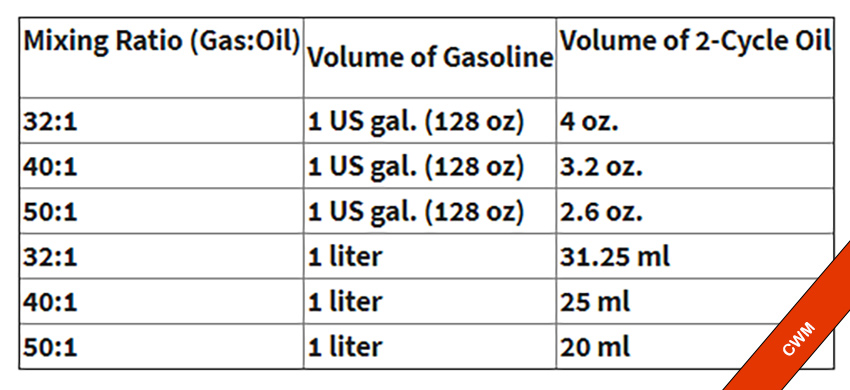Different two-stroke oil mix ratios are recommended by different equipment manufacturers. How confusing!
The lifespan of your chainsaw engine will be compromised if you add too little oil to the gasoline.
Internals will overheat, the piston will seize, components will burn away, and the engine will be rendered unsalvageable.
Table of Contents
If you apply too much oil, the engine may not start, emit a lot of smoke, and the spark plug may become fouled. As a result, getting your 2-stroke chainsaw fuel mix just right is important for safe and long-term operation of your chainsaw.
Unlike your vehicle engine, which lubricates itself with 4 stroke oil contained in an oil sump and pumped by an oil pump, two-stroke engines get their lubrication from 2 stroke oil mixed directly into the fuel.
Resolving varied mix ratio suggestions and combining several containers of gasoline is time-consuming, especially for professionals who operate multiple pieces of equipment. What if there was a single solution that worked in all of your equipment for varied two-stroke oil mix ratios?
2 Stroke Oil Mixture Ratios Explained
If your manufacturer suggests a 50:1 fuel/oil mixture, it implies you’ll need 50 parts gas to one part two-stroke oil. To make one gallon of 50:1 fuel, combine 2.6 ounces of two-stroke oil with one gallon of gasoline, as illustrated in the table below. Don’t worry, we’ll soon eliminate the requirement for a metric chart.

Which is better: pre-made or homemade blends?
The benefit of premixed blends is that you don’t have to worry about the component oil and gasoline quality. You cannot just combine any gasoline and oil for your chainsaw. All of the effort is already done with a premixed blend; all you have to do is pour the mixture into your chainsaw and start it up!
Husqvarna, for example, sells a 50:1 combination of gasoline and oil, particularly for chainsaws. This is one of the best premixed fuel solutions for a 2-cycle chainsaw available.
It comes in one-quart bottles and is ideal for residential users who don’t use chainsaws on a daily basis. However, for professionals and frequent users, making own fuel oil mixes in bigger quantities may be the most cost-effective solution.
Confusion is Caused by Different Mix Ratios
The fact that various equipment manufacturers propose varying oil mix percentages further complicates matters. Most current chainsaws, string trimmers, leaf blowers, and other small-engine two-stroke equipment recommend a 50:1 oil mix ratio, although others prefer 40:1, and older two-stroke equipment may even require a 32:1 oil mix ratio. Traditionally, various pieces of equipment with varying mix ratios would need mixing and storing many cans of gasoline. That’s not just inconvenient, but it’s also a formula for error.
This circumstance can be a major issue for landscapers and other professionals that run many pieces of heavy-duty equipment. However, many households still have older equipment that requires a stronger fuel blend. It would be far more convenient if every manufacturer advised the same mix ratio.
Fuel Oil Ratios for Popular Chainsaw Brands
Stihl: All Stihl-branded chainsaws use a 50:1 gasoline-to-synthetic 2-stroke oil ratio. The suggested gas is 89 octane mid-grade paired with Stihl branded 2-stroke oils.
Husqvarna: offers a variety of premixed fuel combinations as well as synthetic oils. Their premixed oil has a 50:1 ratio and is suited for the majority of their gas-powered chainsaws.
Poulan Pro: offer a 40:1 proprietary fuel blend that is excellent for all of their gas powered products, including chainsaws. As a result, Poulan Pro saws require a thicker oil mix at a 40:1 ratio.
Ryobi: The official Ryobi user handbook for its chainsaws advises a 50-to-1 oil-to-gas ratio.
Remington: Remington chainsaws require a gas-to-oil ratio of 40:1 according to their official online fuel mix instructions.
I hope you found this two-stroke oil mix ratio guide helpful (share if you liked it!). Please let us know what you think in the comments area below. Thank you for stopping by.


Thanks for explaining the 2-stroke oil mixture; I wasn’t sure what I was meant to use for my chainsaw until I read your page as well as downloaded the free chainsaw instruction.
On my old chainsaw, I usually use a 40:1 oil mix, but if I bought a new hedge cutter, I would use a lower oil blend.
Back in the day, which was just a few decades ago, 2-stroke engines with fuel-to-oil ratios as low as 32:1, 20:1, and even 16:1 were widespread. However, these engines were renowned for producing a lot of smoke when operating.
It makes little difference if the ratio is 40:1 or 50:1 as long as you use a high-quality 2-stroke synthetic oil. If you want to produce your own mixes, follow these steps:
Only use high-quality, fresh 2-stroke synthetic oils.
Stick to mid-grade high-octane gas, particularly one with an octane rating of 88–89.
Use ethanol-free gas if you can find it.
If not, continue using E90 and take additional care of your saw by cleaning the fuel tank on a regular basis.
I have an old Husqvarna chainsaw that is supposed to be 40:1 and a Stihl chainsaw that is 50:1 according to the operator manuals I downloaded from your website. Do you think I can get away with using a single container, or do I need to use separate fuel containers for each chainsaw?
Is it important what kind of two-stroke oil I use in my new Echo chainsaw? Is it okay if I use any brand?
Ugh, what was I thinking?! I completely neglected to put any oil in my chainsaw and now it’s payback time. Neglecting oil is a huge no-no and it’s going to cost me. In the future, I’ll make sure to do my due diligence and never forget the oil again.
Oops, I made a mistake by putting 4-stroke oil into my chainsaw and now it’s ruined. I should have double-checked the owner’s manual before using the wrong type of oil. Always make sure to use the recommended oil for your device to keep it functioning properly.
Is it OK to just use cheap generic oil for my chainsaw?
I tell ya what, y’all gotta check out the article “Is There a Single Solution for Different Two-Stroke Mix Ratios?” on Chainsaw Workshop Manual. As someone who knows their way around a chainsaw, I found this article to be a real eye-opener. The writer does a good job of breaking down the different two-stroke mix ratios and the implications of not getting it right. I especially appreciated the tips on how to determine the right mix for your specific saw. So, if you wanna keep your chainsaw running like a charm, give this article a read, y’all!
As an avid chainsaw user, I found the article “Is There a Single Solution for Different Two-Stroke Mix Ratios?” on Chainsaw Workshop Manual to be an informative and helpful resource. The article does an excellent job of explaining the different two-stroke mix ratios and the importance of getting them right to ensure the proper functioning of your chainsaw. The fact that there’s no one-size-fits-all solution makes things a bit complicated, but the article offers valuable tips on how to determine the right mix for your particular saw. Overall, I would recommend this article to anyone who wants to keep their chainsaw in top working condition.
I’ve used chainsaws for various jobs, I can say that getting the right mix ratio is crucial for optimal performance and longevity of the chainsaw. In my personal experience, I’ve had issues with my chainsaw bogging down